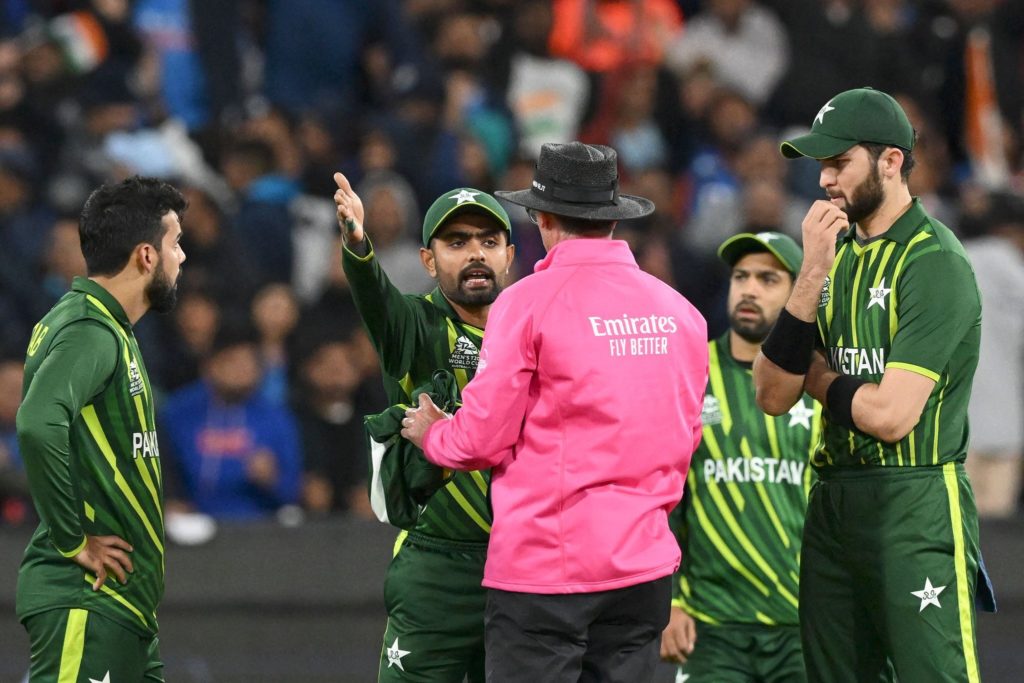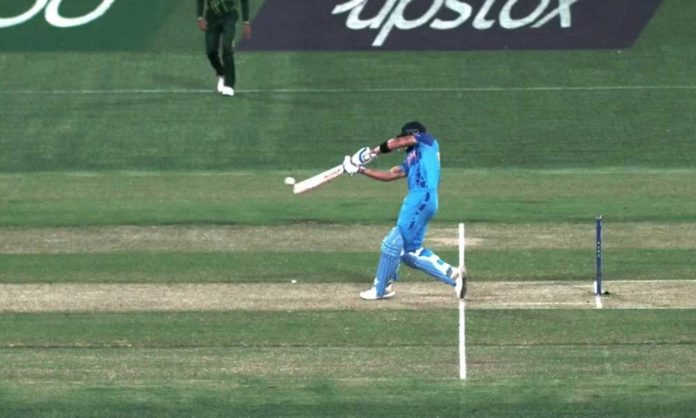Pakistan and India have one of the most heated rivalries in sports history. They never fail to amaze fans across the globe whenever they lock horns. Yesterday was no different. During T20 World Cup 2022 match, 90,293 spectators at the MCG and millions watching at home were treated to the usual dose of the drama of an Indo-Pak clash.
The game was exciting from the get-go, and it delivered many moments of brilliance. The crowd was on their feet; the noise they made could be heard in the suburbs over two kilometers away.
The major highlight of the game was Virat Kohli’s brilliance with the bat, and how he snatched the victory out of Pakistan’s mouth. However, the major talking point about the match were two umpiring decisions, which occurred during the final moments of the game.
Why was no ball not reviewed, then how can it not be a dead ball when Kohli was bowled on a free hit. #INDvPAK #T20worldcup22 pic.twitter.com/ZCti75oEbd
— Brad Hogg (@Brad_Hogg) October 23, 2022
Pakistanis felt robbed of victory, courtesy of those two decisions. From social media to the local tea shop, from experts of the game to the people who only watch cricket once a year, everyone everywhere is talking about it rather than how intense and thrilling the match was.
Hmmmmmm. This should be probed? I don’t know. What do the experts and the rules say ? Because that ball was the #turningpoint and @babarazam258 could be seen protesting with the umpires right after. #NoBall https://t.co/x96gj9mA9M
— Ali Zafar (@AliZafarsays) October 23, 2022
Well, let’s take a detailed look into both of these decisions.
Why did on-field umpires not consult the third umpire to check the full toss no ball?
India needed 13 runs off 3 balls when Mohammad Nawaz bowled a juicy high full toss, which was pulled by Virat Kohli for a six. Square leg umpire Marais Erasmus turned to watch Kohli’s shot go over the fence. After the six was confirmed, Erasmus signaled that the delivery was above the waist, and standing umpire Rod Tucker called a no-ball.
It was a close marginal call, which could have gone either way. The important thing to consider is not how high the ball was when Kohli made contact with it, but rather how high it would have been if it had past him while he was in his stance.
Well, the main question from fans across the globe is ‘if it was a close call, why did umpires not review and use technology to come up with the best possible result?’
Shameful Umpiring by #ICC apparent top brass – got under pressure at such a stage – disgraceful – @iramizraja it’s time to show some guts and register official complaint and review against the #NoBall. Even the next one was a #DeadBall @babarazam258 @TheRealPCB @ICC pic.twitter.com/MFMdB3Dzi7
— Ramazan İzol (@ramazanizoltr) October 23, 2022
The answer to this question is, that according to ICC’s playing conditions, no balls (apart from front-foot no balls, called off the field) can only be reviewed after a dismissal.
Pakistan captain Babar Azam initially protested with umpire Rod Tucker against the decision, but the dust was settled after Erasmus intervened and explained the decision to Babar.

Why was the ball not declared dead after Virat Kohli was bowled on free hit?
India needed six runs off three balls with a free hit to go, Nawaz under immense pressure, bowled the free hit wide, which meant that the free hit was still in effect and the next legal delivery would be free hit.
Nawaz bowled a yorker, which missed Kohli’s bat and crashed into his stumps, and raced toward the third man. Pakistani fielders stood baffled, protesting the ball to be dead rather than chasing the ball, which allowed Kohli and Dinesh Karthik to run three.
Mohammad Rizwan argued with the umpire over the decision, and many fans and experts suggested that the ball should have been declared dead after hitting the stumps.
To clear the air about this incident, we must go through the playing conditions and the MCC’s Laws of Cricket.
According to the MCC Laws of Cricket, the ball can only become dead when “it is finally settled in the hands of the wicketkeeper or of the bowler”, or when “a boundary is scored.” The ball can also be called a dead ball when “a batter is dismissed. The ball will be deemed to be dead from the instant of the incident causing the dismissal.”
Law – 20.1.1 – also states the other different ways of declaring a ball dead, including the times when the umpire has the authority on the decision. With regards to the ball hitting the stumps, the umpire can call the ball dead when “one or both bails fall from the striker’s wicket before the striker has had the opportunity of playing the ball.”
However, the free hit ball doesn’t become dead after hitting the stumps because the batter cannot get out on free hit.
Clause 21.19.2 of the playing conditions is clear: “For any free hit, the striker can be dismissed only under the circumstances that apply for a no ball”.
In other words, the only way a batter can get out on a free hit is either by being run out, for obstructing the field or hitting the ball twice.
So although Kohli was ‘bowled’ he was not dismissed, meaning the ball remained in play and not dead.
‘If a batsman is caught on a free hit he can run and the score will be added to his total & if he is bowled with an edge then he can take runs which will be added to his total. But if he gets out bowled without an edge, he can run but the runs will go into extras’ (byes)
— Dr. Nauman Niaz (@DrNaumanNiaz) October 23, 2022
Conclusion:
Hope the dust is settled now. It was all fair and abiding the rules of the game to not call the ball dead, and award 3 runs to India, whereas in no ball’s case, it was a close call, so it is debatable, but that is the beauty of cricket. It is the game of the smallest of margins, and these kinds of incidents can happen with any team at any time, so fans should accept things gracefully rather than indicating foul play without understanding the rules and laws of the game.







































